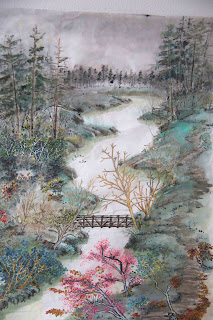I can fondly remember the Napoleon ice cream in my days as a kid growing up in Hong Kong. Strawberry, vanilla and chocolate flavors in pink, white and brown stripes. The challenge was how to savor the treat for the longest duration before it melted away in the non-air-conditioned room.
I did the 3 styles of Beaverton Creek ( Beaverton Creek, Beaverton Creek Yellow, Beaverton Creek Classical ) to hopefully answer my own question; What is Chinese Brush painting.
I know I had discussed this topic in my last few blogs, I thought I would use these 3 pieces to illustrate my assertion. The givens were, all three were done using Chinese brush and pigments on Xuan.
The most impressionistic of the 3 belongs to this one done in green. The painting exudes a strong "feeling" that is abstract and yet tactile at the same time. One can almost paddle the kayak through the water and be mesmerized. Aside from the split hair and splash ink technique, it does not look very Chinese. I'll submit this work looks more western than Chinese, despite Chinese brushes being employed.

There is definitely a lot more traditional Bi-Fa in the Beaverton Creek Yellow although the composition is not very Chinese. It should be evident that the artist had training in Chinese Brush landscape and uses "chuen" and contour lines to describe shape and topography. Some of the lines depicting stalks and trunks showed center tip calligraphic characteristics. So can we consider this one under Chinese Brush painting, even when its composition is identical to the top one? Must a Chinese Brush painting look traditional? When is this a "watercolor" as some might call it and not a Chinese Brush painting?
I am sure not a lot of people would have problem classifying this as a Chinese Brush painting. So what is different about this one?
Granted the bridge was absent from the other two, but that does not make this more Chinese than the others.
We can't get very far from this discussion without addressing Bi-Fa again. I still think this is the quintessential element in defining Chinese Brush painting. One must show not only the presence, but the craftsmanship of the brushstrokes. The traditional brush rendition of shrubs and shores helped to cement this in the Chinese Brush painting category.
We mentioned the Three Perspective concept in traditional Chinese Brush landscape paintings. This work here employed all three. The void space at the bottom of the woods in the distance added to the Level perspective. The meandering shorelines and all the little details along the banks defined the Depth perspective. Along with height described by the few stands of fir, one gets the birds eye view of Beaverton Creek; thus gently gliding over it, enjoying the little tidbits of information that each section gives off.
The composition falls within a classical doctrine.. a literal translation would be One River Two Shores. The painting is dissected somewhat diagonally by the creek, with contrast on both banks. Left bank is more densely vegetated, thus the Yang, The right side would be the Ying. However the Ying side actually created conflict by harboring the attention grabbing pink trees. Leaves are present only on some of the trees, again creating contrast. Complementing contrast is harmony; opposite banks are linked not only by the bridge, but by tree trunks leaning towards each other, by the pink answering the blue, by sharing the ducks.
Although the painting employs many color, the overall feel is not "Su", or ostentatious.
I would not be so crass as to claim that I have thought of all these attributes before I laid my first brushstroke on this painting; a lot of these points are anecdotal. The fact remains that much thought has gone into these 3 paintings to raise a point, What Is Chinese Brush Painting.
































